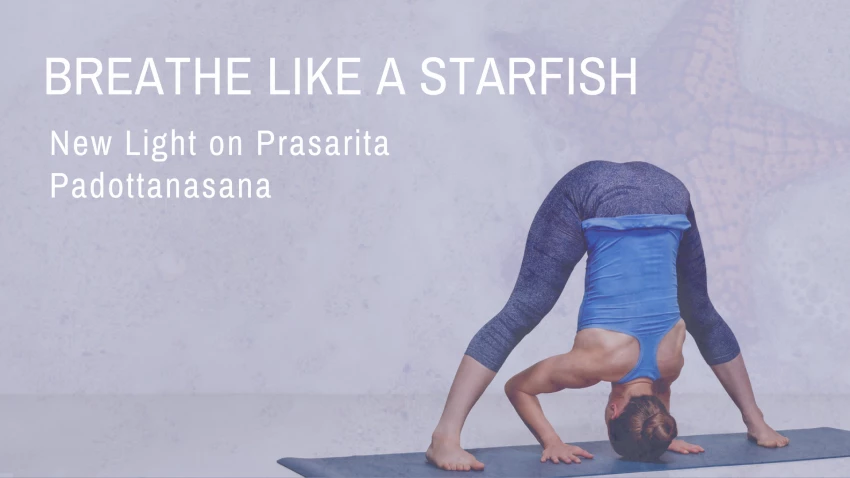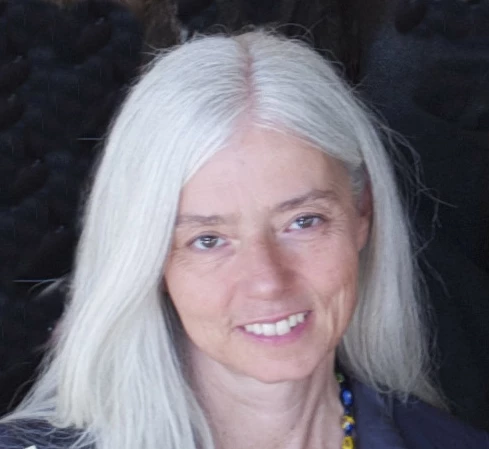Breathe Like a Starfish: New Light on Wide-Legged Forward Bend (Prasarita Padottanasana)

Our limbs include our arms, legs, tailbones, and heads. Way back at a time few of us remember—in utero—all our nutrients came to us through our navels and then radiated out to all our limbs. Through the umbilical cord, we took in nourishment and oxygen that was then distributed to the outlying areas of our bodies.
For our first six months or so outside the womb, our bodies imitated this starfish-like breathing pattern, termed navel radiation. Navel radiation helped us unfurl our limbs so that we could begin to move about the world.
Navel radiation is a pattern that can help us open freely into yoga poses even as adults. We can intentionally extend the breath energy into all our limbs by freeing the belly for abdominal-based breathing.
Freeing the belly is key. Your torso—chest and abdomen—are the intersection between the arms, legs, head, and tailbone. When we chronically suck in our bellies, that intersection becomes blocked, inhibiting the flow of energy among the limbs.
Like all standing poses, Prasarita Padottanasana (Wide-Legged Standing Forward Bend) expresses navel radiation simply through its shape, making exploring this vital breathing pattern easy.
How to Practice Wide-Legged Standing Forward Bend (Prasarita Padottanasana)

- Begin by standing on a nonskid mat with your feet hip-width apart. Jump or step your feet out to a wide stance, about a leg-length apart. If you extend your arms straight out from your shoulders, your feet should be directly below your hands.
- Plant your feet into the ground, feeling the footprint you are making on your mat. Are the inner and outer heels and balls of your feet planted evenly? If not, chances are you may feel the weight sagging into your inner feet. Allow the muscles and skin of your outer legs to stream down along your bones from your hips to your outer feet to help you root the feet more evenly.
- Raise your arms to a “Y” position (think “YMCA”—the song). Relax your abdomen and breathe deeply into it. Imagine sending your inhalation from your center up and down the spine to the head and tailbone. When you feel the connection between head and tailbone, begin to explore sending the inhalation out into your limbs, all the way to the fingers and toes. Allow your body to settle on each exhalation. Take 5 to 10 breaths.
 Release your arms and place your hands on your hips.
Release your arms and place your hands on your hips.- Bending from the pelvis, let your torso come forward as far as it will go without losing contact with deep breathing.
- Place your hands on the floor if they reach, on yoga blocks, or on the seat of a chair.
- Again, explore navel radiation first from head to tailbone, then move the breath out into all the limbs.
- Stay for 5 or 10 deep breaths. If you can’t feel the breath radiating outward, you are probably pushing too far. Lift your torso up a bit until your breath feels free.
- If you want to stretch your shoulders and chest, you can clasp your fingers behind your back and extend your arms out behind you with your
 palms facing your back. Another option for opening your chest and shoulders is to place your palms together behind your back.
palms facing your back. Another option for opening your chest and shoulders is to place your palms together behind your back. - Rock your weight back into your heels so your sit bones are further back than your heels.
- With your hands on blocks or the floor, slide your hands (and blocks) forward so that your arms are outstretched and your torso and arms feel long and extended. Most of the weight should be on your feet, especially your heels, so that if you lift your hands off the floor, you don’t feel as if you’re going to fall on your face. Plant your feet deeply into your mat, and every few breaths, if your body is willing, creep your hands forward, millimeter by millimeter, simultaneously stretching your sit bones back.
- Take five or ten deep breaths, sending the breath out into all your limbs. Then, walk your hands back toward you, placing them on your blocks or
 on the floor in a neutral tabletop position.
on the floor in a neutral tabletop position. - Place your hands on your hips and lift back up to an upright position.
- Place your palms together in front of your heart, bend your knees slightly, and allow the weight of your pelvis to release into your legs. Relax your abdomen and breathe deeply, resting.
Wide-legged forward Bend (Prasarita Padottanasana) is one of yoga’s most balanced standing poses. Its symmetrical shape keeps your pelvis, sacroiliac joint, and spine neutral and quiet, while the active rooting of your feet and legs allows your upper body to be soft and receptive. I like to settle into Prasarita in between standing poses to allow my body to ground and integrate. Use it with navel radiation to help you unfurl your limbs after a good night’s sleep or a long day at the computer.
Another Yoga Pose Primer from contributor Charlotte Bell and YogaUOnline – Garudhasana: How To Spread Your Wings.
 Charlotte Bell began practicing yoga in 1982 and began teaching in 1986. She was certified by B.K.S. Iyengar in 1989 following a trip to Pune. In 1986, she began practicing Insight Meditation with her mentors Pujari and Abhilasha Keays. Her asana classes blend mindfulness with physical movement. Charlotte writes a column for Catalyst Magazine and serves as editor for Yoga U Online. She is the author of two books: Mindful Yoga, Mindful Life and Yoga for Meditators, both published by Rodmell Press. She also edits the Hugger Mugger Yoga Products¹ blog and is a founding board member for GreenTREE Yoga, a non-profit that brings yoga to underserved populations. A lifelong musician, she plays oboe and English horn in the Salt Lake Symphony and the folk sextet Red Rock Rondo, whose 2010 PBS music special won two Emmys.
Charlotte Bell began practicing yoga in 1982 and began teaching in 1986. She was certified by B.K.S. Iyengar in 1989 following a trip to Pune. In 1986, she began practicing Insight Meditation with her mentors Pujari and Abhilasha Keays. Her asana classes blend mindfulness with physical movement. Charlotte writes a column for Catalyst Magazine and serves as editor for Yoga U Online. She is the author of two books: Mindful Yoga, Mindful Life and Yoga for Meditators, both published by Rodmell Press. She also edits the Hugger Mugger Yoga Products¹ blog and is a founding board member for GreenTREE Yoga, a non-profit that brings yoga to underserved populations. A lifelong musician, she plays oboe and English horn in the Salt Lake Symphony and the folk sextet Red Rock Rondo, whose 2010 PBS music special won two Emmys.



